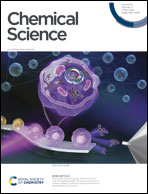Fine-regulation of gradient gate-opening in nanoporous crystals for sieving separation of ternary C3 hydrocarbons†
Abstract
The adsorptive separation of ternary propyne (C3H4)/propylene (C3H6)/propane (C3H8) mixtures is of significant importance due to its energy efficiency. However, achieving this process using an adsorbent has not yet been accomplished. To tackle such a challenge, herein, we present a novel approach of fine-regulation of the gradient of gate-opening in soft nanoporous crystals. Through node substitution, an exclusive gate-opening to C3H4 (17.1 kPa) in NTU-65-FeZr has been tailored into a sequential response of C3H4 (1.6 kPa), C3H6 (19.4 kPa), and finally C3H8 (57.2 kPa) in NTU-65-CoTi, of which the gradient framework changes have been validated by in situ powder X-ray diffractions and modeling calculations. Such a significant breakthrough enables NTU-65-CoTi to sieve the ternary mixtures of C3H4/C3H6/C3H8 under ambient conditions, particularly, highly pure C3H8 (99.9%) and C3H6 (99.5%) can be obtained from the vacuum PSA scheme. In addition, the fully reversible structural change ensures no loss in performance during the cycling dynamic separations. Moving forward, regulating gradient gate-opening can be conveniently extended to other families of soft nanoporous crystals, making it a powerful tool to optimize these materials for more complex applications.



 Please wait while we load your content...
Please wait while we load your content...